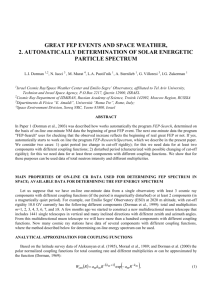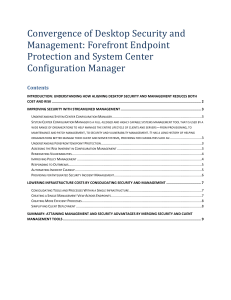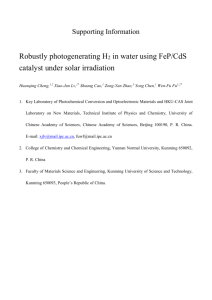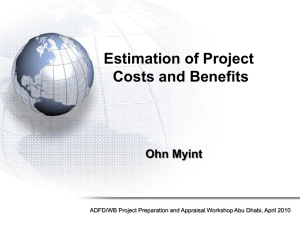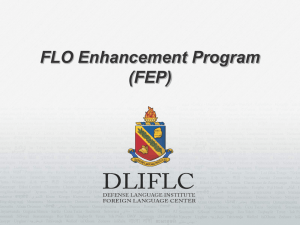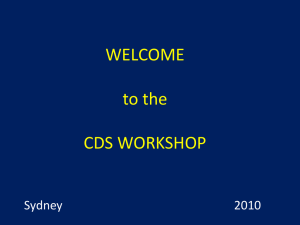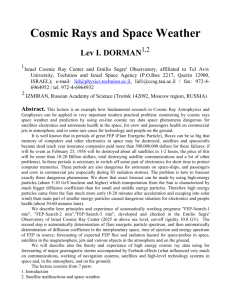4. combining ground and satellite cr measurements for on-line
advertisement
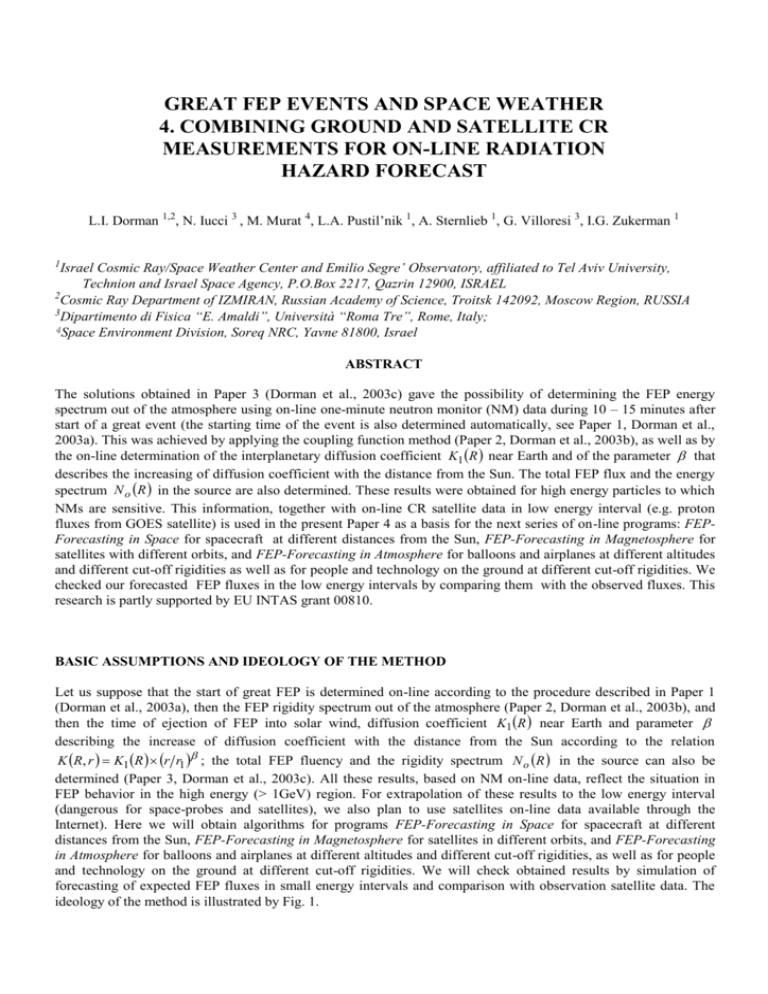
GREAT FEP EVENTS AND SPACE WEATHER 4. COMBINING GROUND AND SATELLITE CR MEASUREMENTS FOR ON-LINE RADIATION HAZARD FORECAST L.I. Dorman 1,2, N. Iucci 3 , M. Murat 4, L.A. Pustil’nik 1, A. Sternlieb 1, G. Villoresi 3, I.G. Zukerman 1 1 Israel Cosmic Ray/Space Weather Center and Emilio Segre’ Observatory, affiliated to Tel Aviv University, Technion and Israel Space Agency, P.O.Box 2217, Qazrin 12900, ISRAEL 2 Cosmic Ray Department of IZMIRAN, Russian Academy of Science, Troitsk 142092, Moscow Region, RUSSIA 3 Dipartimento di Fisica “E. Amaldi”, Università “Roma Tre”, Rome, Italy; 4Space Environment Division, Soreq NRC, Yavne 81800, Israel ABSTRACT The solutions obtained in Paper 3 (Dorman et al., 2003c) gave the possibility of determining the FEP energy spectrum out of the atmosphere using on-line one-minute neutron monitor (NM) data during 10 – 15 minutes after start of a great event (the starting time of the event is also determined automatically, see Paper 1, Dorman et al., 2003a). This was achieved by applying the coupling function method (Paper 2, Dorman et al., 2003b), as well as by the on-line determination of the interplanetary diffusion coefficient K1 R near Earth and of the parameter that describes the increasing of diffusion coefficient with the distance from the Sun. The total FEP flux and the energy spectrum N o R in the source are also determined. These results were obtained for high energy particles to which NMs are sensitive. This information, together with on-line CR satellite data in low energy interval (e.g. proton fluxes from GOES satellite) is used in the present Paper 4 as a basis for the next series of on-line programs: FEPForecasting in Space for spacecraft at different distances from the Sun, FEP-Forecasting in Magnetosphere for satellites with different orbits, and FEP-Forecasting in Atmosphere for balloons and airplanes at different altitudes and different cut-off rigidities as well as for people and technology on the ground at different cut-off rigidities. We checked our forecasted FEP fluxes in the low energy intervals by comparing them with the observed fluxes. This research is partly supported by EU INTAS grant 00810. BASIC ASSUMPTIONS AND IDEOLOGY OF THE METHOD Let us suppose that the start of great FEP is determined on-line according to the procedure described in Paper 1 (Dorman et al., 2003a), then the FEP rigidity spectrum out of the atmosphere (Paper 2, Dorman et al., 2003b), and then the time of ejection of FEP into solar wind, diffusion coefficient K1 R near Earth and parameter describing the increase of diffusion coefficient with the distance from the Sun according to the relation K R, r K1 R r r1 ; the total FEP fluency and the rigidity spectrum N o R in the source can also be determined (Paper 3, Dorman et al., 2003c). All these results, based on NM on-line data, reflect the situation in FEP behavior in the high energy (> 1GeV) region. For extrapolation of these results to the low energy interval (dangerous for space-probes and satellites), we also plan to use satellites on-line data available through the Internet). Here we will obtain algorithms for programs FEP-Forecasting in Space for spacecraft at different distances from the Sun, FEP-Forecasting in Magnetosphere for satellites in different orbits, and FEP-Forecasting in Atmosphere for balloons and airplanes at different altitudes and different cut-off rigidities, as well as for people and technology on the ground at different cut-off rigidities. We will check obtained results by simulation of forecasting of expected FEP fluxes in small energy intervals and comparison with observation satellite data. The ideology of the method is illustrated by Fig. 1. Fig. 1. Illustration of the ideology of the FEP forecasting method FORECASTING OF EXPECTED FEP ENERGY SPECTRUM, FEP FLUX AND FEP FLUENCY (PROPORTIONAL TO THE RADIATION DOSE) IN THE SPACE AT DIFFERENT DISTANCES FROM THE SUN Let us suppose, that the diffusion coefficient K R, r K1 R r r1 . (1) and by the procedure described in Paper 3 (Dorman et al., 2003c) we have determined diffusion coefficient K1 R , parameter , time of ejection Te and rigidity spectrum N o R in the source. In this case according to Parker (1963), the expected FEP density at the moment T and distance r from the Sun will be nR , r , T N o R r13 2 T Te K1 R 3 2 r1 r 2 , exp 4 2 2 2 3 2 2 T Te K1 R (2) where r1 1.5 1013 cm 1 AU . The expected integral flux I s r , T , Ek min inside the space-probe with the threshold energy Ek min at distance r from the Sun and at moment T will be I s r , T , Ek min Ek min N o REk 2 2 r r 2 r13 2 T Te K1 REk 3 2 1 dE , (3) exp k 4 2 T Te K1 REk 2 3 2 and the total fluence Fs r , Ek min on a space-probe during the whole event (proportional to the radiation dose) will be 2 2 r r 2 r 3 2 T Te K1 REk 3 2 1 dE N o REk 1 exp 4 2 k T T K R E 2 3 2 e 1 k E k min Fs r , Ek min dT Te (4) FORECASTING FOR THE EARTH’S MAGNETOSPHERE Inside the Earth’s magnetosphere the expected FEP energy spectrum will be determined by Eq. 2 at r r1 1 AU . For satellites at different cut-off rigidities Rc T inside the Earth’s magnetosphere the expected FEP flux will be I s T , Rc T N o R Rc T r13 2 T Te K1 R 3 2 2 4 2 3 2 2 2 r 2 1 dR exp T Te K1 R (5) where Rc T is determined by the orbit of satellite. The expected fluency on a satellite with orbit Rc T during the whole event (proportional to the radiation dose) will be Te Rc T Fs Rc T dT N o R r13 2 T Te K1 R 3 2 2 4 2 3 2 2 2 r 2 1 dRdR exp T Te K1 R (6) FORECASTING OF EXPECTED INTENSITY OF SECONDARY COMPONENTS GENERATED BY FEP IN THE EARTH’S ATMOSPHERE AND EXPECTED RADIATION DOSE FOR PLANES AND GROUND OBJECTS ON DIFFERENT ALTITUDES AND DIFFERENT CUT-OFF RIGIDITIES. The expected intensity of the secondary component of type i (electron-photon, nucleon, muon and others) generated in the Earth’s atmosphere by FEP at moment of time T at some point characterized by pressure level ho and cut-off rigidity Rc will be as follows: I si T , Rc , ho r 3 2 T Te K1 R 3 2 1 N o R Rc 2 4 2 3 2 2 2 r 2 1 W R, h dR exp , o T Te K1 R i (7) where Wi R, ho is the coupling function. The expected total fluency (proportional to the radiation dose) for planes and ground objects on different altitudes and different cut-off rigidities will be determined by integration of Eq. 7 over the whole event and summarizing over all secondary components: 2 2 r 2 r13 2 T Te K1 R 3 2 1 W R, h dR exp , Y s Rc , ho dT N o R o 4 2 i T T K 2 3 2 i Te Rc e 1 R (8) PREDICTION OF FEP FLUXES AND TOTAL FLUENCY USING BOTH ON-LINE GROUND AND SATELLITE DATA In Paper 3 (Dorman et al., 2003c) we made simulation of FEP flux forecasting on the basis of on-line ground data only. It was shown that the considered model of FEP generation and propagation in the energy range of several GeV worked well: by using 15-20 minutes of NM data at the beginning of the event the program forecasts the time development of the FEP event. Fig.2. Predicted FEP integral fluxes for Ek Eo 0.1GeV , Ek Eo 1GeV , Ek Eo 3 GeV . The forecasted integral flux for Ek Eo 0.1GeV we compare with observed fluxes for Ek 100 MeV on GOES satellite. The ordinate is log10 of FEP integral flux (in cm-2sec-1sr-1), and the abscissa is time in minutes from 10.00 UT of September 29, 1989. The problem is how to extrapolate the FEP energy spectrum from high NM energies to very low energies detected in GOES satellite. The main idea of this extrapolation is as following: the source function, time of ejection and diffusion coefficient in both energy ranges are the same. The source function relative to time is function, and relative to energy is power function with an energy-dependent index ( o a ln Ek Ek max : No R, T T Te R o a ln Ek Ek max . (9) We suppose for the diffusion coefficient K R, r in the interplanetary space power function from the distance to the Sun (as r r1 ) and power function for the transport path, so that K R, r K1 R r r1 , (10) K1 R K1 v c R R1 , (11) where and v is particle velocity, R1 =1 GV. Parameter was determined in Paper 3 (Dorman et al., 2003c) from NM data ( 0.6 ). We suppose that for the low energy range parameter is the same. Time of ejection Te was also determined from NM data (see Paper 3, Dorman et al., 2003c). Again we assume that it remains the same for the low energy range. The fitting of the parameters o , a, Ek max , was performed every 5 minutes, using more and more data: we start from t = 105 min (calculated from 10.00 UT September 29, 1989) and use the data of first five minutes; then our program performs a fit for t = 110 min using the first ten minute data, and so on. The volume of the data used increased proportionally with time. In Fig. 2 are shown the predicted FEP integral flux for Ek Eo 0.1GeV , Ek Eo 1GeV , Ek Eo 3 GeV . The predicted integral flux for Ek Eo 0.1GeV is compared with the observed integral flux for the same energy, as measured by the GOES satellite. From Fig. 2 it can be seen that the agreement between the predicted and observed FEP integral flux for Ek Eo 0.1GeV is excellent after 30-40 minutes from the onset of the event. The agreement continues to more than 2500 minutes (about two days). FORECASTING OF EXPECTED TOTAL FEP FLUENCY In Fig. 3 we show the results of calculations for the expected total (event-integrated) FEP fluence for Ek Eo 0.1GeV . Fig. 3. Predictions of the expected total (event-integrated) FEP fluency for Ek Eo 0.1GeV . The ordinate axis is the log10 of the total FEP fluency (in cm-2sr-1), and the abscissa is time when the prediction was made, in minutes from 10.00 UT of September 29, 1989. ALERTS IN CASES IF THE FLUXES ARE EXPECTED TO BE DANGEROUS If the predicted fluxes are expected to be dangerous for spacecraft operations, preliminary "FEPAlert_1/Space", "FEP-Alert_1/ Magnetosphere", "FEP-Alert_1/ Atmosphere” and "FEP-Alert_1 /Ground” alerts will be sent in the first few minutes after the event. As more and more data become available, better predictions of the expected fluxes will be made. On the basis of these predictions, more definitive Alert_2, Alert_3 and so on will automatically be issued. These Alerts will give information on the expected time and level of dangerous situation for different objects in space, in magnetosphere, in atmosphere on different altitudes and at different cut-off rigidities; experts must decide what to do operationally: for example, for space-probes in space and satellites in the magnetosphere to switch-off the electric power for 1-2 hours to save the memory of computers and high level electronics, for jets to decrease their altitudes from 10-20 km to 4-5 km to protect crew and passengers from great radiation hazard, and so on. CONCLUSION By this series of Papers 1-4 we show that by using on-line data from ground NM in the high energy range and from satellites in the low energy range during the first 30-40 minutes after the start of the FEP event, it is possible to predict the expected FEP integral fluxes for different energies up to a few days ahead. The total (event-integrated) fluency of the event, and the expected radiation hazards can also be estimated. ACKNOWLEDGEMENTS: This research is partly supported by EU INTAS Grant 00810. REFERENCES Dorman L.I. et al., Paper 1, This Issue, 2003a. Dorman L.I. et al., Paper 2, This Issue, 2003b. Dorman L.I. et al., Paper 3, This Issue, 2003c. E-mail address of Lev I. Dorman: lid@physics.technion.ac.il, lid1@ccsg.tau.ac.il Manuscript received ; revised , accepted
